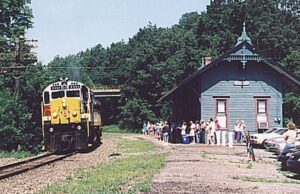Railroading at the Delaware Water Gap
By Mike Rotolo
On Saturday July 29, 2000 Members of the Lackawanna Chapter of the Railway & Locomotive Historical Society Inc. saw a Norfolk/Southern freight train pass by one of many stations subject to refurbishment. The locomotive was a diesel road # 8950.
This station, located on the Delaware River had overgrown vines and shrubs, construction debris and road materials that had buried what many consider a transportation jewel from the turn of the century.
Members of the Delaware Water Gap Station Restoration Project of the Lackawanna Chapter of the Railway & Locomotive Historical Society Inc. spent the last 6 months cleaning up the site. On that Saturday, 25 of the members who helped on this project gathered at the site to view the progress to date.
Delaware Water Gap Borough Councilmen Bob Clarkson said, “To me, I see a lot just in the cleanup. You couldn’t walk through the door before”.
The society is paying the borough $1 a year for 5 years while society members raises up to $1 million dollars toward the restoration of the 1903 station. One of the board members of the RLHS, Dr. Frank Allen, had this to say. “This was the gateway to the Poconos at the turn of the century”.
In the early 1900’s, people traveled by train from Philadelphia and New York to stay at one of the 50 resorts, which dotted the Delaware River’s landscape. Dr. Allen also mentioned that this would be the beginning of tourism in this country, second to Niagara Falls at this time. Scanning peeling walls in the passenger waiting room Dr. Allen said, “This is a vestige of what used to be”. And “I love the Railroad. It was the best from of transportation ever invented besides passenger ships. Now both are gone”
Chris Barbieri, Chairman of the Lackawanna Chapter of the Railway and Locomotive Historical Society, Inc. showed visitors around the station, which was previously used by the borough to store road materials and as a place for contractors working on borough projects to store construction materials. Those items, plus the overgrown vegetation, had since been removed from the grounds.
In the freight station, two large overhead doors are now operational. This building has a large freight room, which was used to store passengers trucks and large items to be shipped were stored; a small freight room; and a parcel room. Only the parcel room needs to be cleaned up.
Collected items like bits of the structure, which is necessary for restoration and stone window lintels and bricks, is stacked in the building.
Inside the train station, the elegance of a bygone era is still in evidence. The beauty of the terrazzo marble floors, scarred from construction materials, can be seen in a circular test cleaning spot. Muriatic acid reveals pink marble surrounding terrazzo squares.
The borough did all they could to keep out the vandals, but unfortunately a lot of the architectural items were taken. To name a few, the chandeliers are gone, the architectural brackets from the ceiling corners. Even some stone wainscoting from the mailroom and a thick slab of slate, which was used in the woman’s bathroom stalls, has all disappeared.
Even though the Boy Scouts used the passenger room to play basketball in the 1960’s, we have a good idea of what it looked like, so we can restore it to it’s original conduction.
Barbieri, also noted that this station was “built for the ages”, “All of the other stations on the Lackawanna run were made of wood.”
When this station was built, the railroad president recognized the growth of tourism in the Poconos. They decided they need a really nice station, because of this a concrete and mason block foundation, marble flooring, stone, bricks, walnut, and slate were used.
They wanted “tourists” to get off at a station that was the best they could give to them.
Question—Why try to save a dilapidated structure now?
Answer—Chris Barbieri said, “As a rail organization, from a narrow perceptive, to see the station saved as historic reminder of what the railroad did for the community. As an economic benefit, we believe the whole area by the river can be turned into a public use area.
Nature activities, educational purposes and a meeting site all come to mind. The group also plans for a museum on the site. Barbieri also said, “We see it as an undeveloped resource, without the station, it’s just a piece of land. With the station it can be used as a meeting place”.
During the directors meeting, the group decided to cover a portion of the roof with tin roof and other sections with tarp to winterized the building, thus allowing time to concentrate on fund-raising.
Much work is being done to restore the once rail service between Scranton, PA and New York City, NY. I will be working on information on how this process is coming along.
At this time, I would like to thank Dr. Frank Allen and Chris Barbieri and their members of their organizations for all their hard work on their many projects.
Happy Railroading






